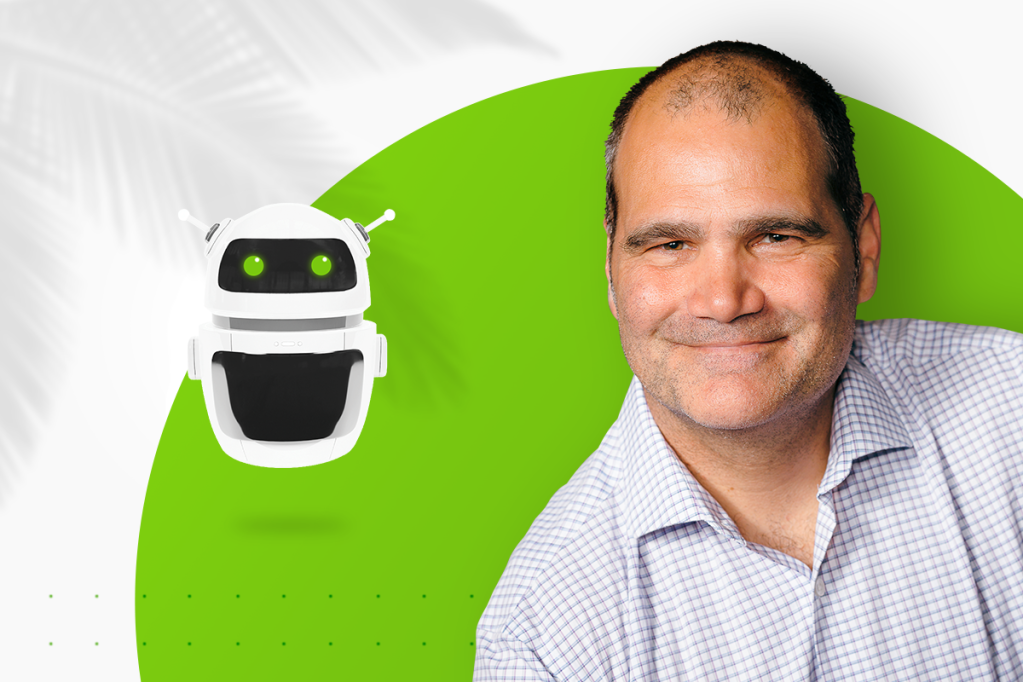We’re excited to share the inside scoop on one of our latest and most advanced technologies: RentCafe Chat IQ. We’ve written about the ways chatbots can help property managers. But we were curious: What makes our bot unique? Why is it well-positioned to make work easier for you? What even goes into the making of a chatbot with artificial intelligence?
Lucky for us, Patrick Lawler had the answers. Patrick is the senior director of residential software development for Yardi. That includes products for the RentCafe Suite such as marketing websites, online portals, CRM tools and more. And now, he’s a lead developer on Chat IQ. Because he’s been with Yardi for over 20 years, we couldn’t have asked for anyone better to put some pretty complicated ideas into language we can all understand.

Thank you for being with us today, Patrick! To start us off, would you talk about your role in developing Chat IQ?
I was involved very early on in the research and development stages. We started out by researching two technologies: artificial intelligence and machine learning. This was an interesting experience for me because my education is in applied mathematics, and this is one of the times where my education had some application to my job.
Who else is involved in this project?
We have an extremely strong team of developers working on the different pieces. They come from all around the world. We have people in the U.S., Canada and India all working on this project. It’s turned into quite a large team.
Early on, the team was much smaller. Each person took it upon themselves to learn the technology, learn the terminology and learn the difference between machine learning and artificial intelligence.
Most people have at least heard of AI, but what’s machine learning?
There’s actually not a single answer. If you look at machine learning and artificial intelligence, there are different categories, even different philosophies on how machine learning should be applied and where the artificial intelligence is rooted.
We settled on something called an artificial neural network, or ANN.
Artificial neural networks are named that way because they’re somewhat modeled after how the brain works. You have these neurons, and they take an input. And from that input, they make some calculations and come back with an output.
Editor’s note: Everybody got that?
That’s where machine learning comes in, because machine learning is part of that input/output part: The more you put in, the more accurate the output.
That’s clearer, but is there an even simpler way to explain the difference between machine learning and artificial intelligence?
I mentioned before that our AI is the artificial neural network. So, let’s take that as an example. AI is a model that can calculate an output based off an input.
So, if you’re an employer, or property manager, you may have wondered, “What is the likelihood one of my residents is going to renew their lease?” AI can come up with a formula that defines the likelihood of a renewal. That’s the artificial intelligence: a formula, or algorithm. And that’s it! It sits there by itself and does nothing until you try it.
Machine learning happens when you take that algorithm and pop a whole bunch of data into it to get results. Then, those results are either right, wrong or somewhere in between. So, you tweak your algorithm and feed it data again.
When people talk about artificial intelligence and machine learning, just know they go hand-in-hand (at least for chat bot applications). You don’t really have any product without both.
When we first reached out to you to do this interview, you said this was perfect timing because you had a story, or an inspiration, that had just happened.
I was working on call center scenarios the other day, and I ended up doing some research for a customer by listening to a call recording. An applicant to a certain property had called the management company to ask a very simple question: “Who do I make the check out to?”
They were about to become a resident and needed to drop off a payment at the office. With Chat IQ, questions like this can be answered. If the bot can’t figure it out on its own, it can be trained. Anyone with access can simply log into the admin module for Chat IQ, create the question and train the bot on how to answer it. In just a couple of minutes, you can add the question, add the answer, train the system and publish and updated data model to production.
As developers, we call this a data model. Property managers can update this data model with new questions and answers at any time. This trains the AI.
The way this works in practice is very simple. In the world of natural language processing, a question/answer scenario is called an intent. Think of it like an FAQ for your artificial intelligence to draw from.
In this example from the call center conversation, the intent is “who do I make this check out to?” As developers, we must define all the questions that may trigger the right answer.
They might say, “Who do I write this check out to?” or “Who is this check payable to?” We train the bot to come up with all the different variations of these questions. Then, anyone who asks a similar or exact question gets the correct answer back. This way, a phone call that would have previously required a leasing agent can now be answered by the chatbot, 24/7.
There are thousands of chatbots out there, and we’ve all encountered them at some point. What are some of the things you like about existing chatbots that made it into Chat IQ?
In anything that’s consumer facing, we need to talk about the user experience. There’s a visual aspect of the user experience, and there’s the personal aspect of it.
We decided early on that we’re not going to try to replace a human. We weren’t even going to pretend, and we’re not going to fake it or try to trick people into thinking they might be communicating with a real person. We’re going to be straightforward: This is a bot, this is an artificial intelligence, and we know it has a limitation.
It’s going to try to answer your question. If it can’t find the answer, we don’t want to frustrate the customer — we’ll get a person involved at that point.
How did you decide what to build and how did you use your experience to make decisions?
A huge part of AI is the machine learning, which is only as good as the data. You must have data to pump into the machine to train it. A lot of AI projects suffer from the lack of good data, and good data has different flavors to it. There’s quantity and there’s quality.
Data is worthless if you’ve got millions and millions of records, but they’re random or inconsistent. We’re fortunate enough that we have the data because we have a call center.
We’re able to go through our call center where we have live chats happening in both voice and text. We’re able to find the most common questions, see the low-hanging fruit and start there.
For property managers out there who may have seen other chatbots on the market, what makes Chat IQ, which is specific to just this industry, better than a general-purpose bot?
One of the powerful aspects of all Yardi solutions is that they sit on top of an extremely robust database. Because of this database, we know the types of questions that get asked, we know the answers and we know how to phrase the answers in a conversational way. Other bots can do a lot of this, but they don’t have our database access.
Plus, unlike those third-party bots, we’re not asking our customers to program the most common questions and answers. Out of the box, this bot will answer all of your standard marketing and leasing questions based off what you’ve already set up in RentCafe. The property manager has already entered their office hours, amenities, availability, pricing, application fees, etc. All that information goes straight into Chat IQ. If anything changes, say you update your office hours, the property manager only has to make those updates once in RentCafe and they’re immediately reflected in the bot’s responses.
Again, with a third-party chatbot, somebody must manage answers in a separate platform and keep them updated all the time.
What is the primary benefit for clients using Chat IQ?
By saving all this time, our customers can refocus their employees on higher-value tasks. That means they can work with existing customers or prospects that are further down the pipeline. Generally speaking, that work is more important than spending all day answering, “What is your pet policy?” and “Who do I make the check out to?”
To close out, how do you see Chat IQ evolving in the coming months?
For property managers, the main purpose of Chat IQ is to provide simple answers to relatively straightforward questions. AI is very good at that. We’re working on resident intents now so Chat IQ can be used by our clients to improve the customer experience, not just the prospect experience.
Stats on leads
Before we concluded the interview, we asked Patrick if he had any user stats on Chat IQ. Here’s what he delivered:
From June 1-30, 2021:
- Property management businesses selected: 5
- Total properties among five companies: 147
- Conversations: 27,419
- FAQs answered: 5,937
- Hours saved: 850
Per company breakdown (average):
- Conversations: 5,483
- FAQs answered: 1,187
- Hours saved: 170
We’d like to thank Patrick Lawler again for taking time out of his day to talk with us about Chat IQ. If you have questions about using it with Yardi Breeze Premier, please contact us for a demo. Chat IQ is also available to Yardi Voyager clients as part of the RENTCafé Suite of products.



